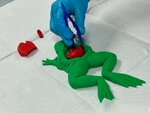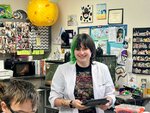Wind: mph,
Welcome to our new web site!
To give our readers a chance to experience all that our new website has to offer, we have made all content freely avaiable, through October 1, 2018.
During this time, print and digital subscribers will not need to log in to view our stories or e-editions.


Lauren Apodaca’s classroom at Vista Middle School was buzzing with conversation as students working in groups focused on the internal anatomy of frogs on the table before them, turning over heart, liver and other internal organs with forceps.
If you have memories of dissecting frogs or other animal specimens in science class, you probably remember the smell of formaldehyde and other chemicals used to preserve the specimens. That distinct odor was absent from this classroom. The frogs on the tables and their innards were all produced in the classroom on a 3D printer.
The equipment was purchased through the Pennsylvania-based nonprofit Animalearn, which promotes humane science education as a division of the American Anti-Vivisection Society. Apodaca, who is in their seventh year of teaching, recently earned honorable mention as a nominee for Animalearn’s 2023 Humane Science Educator of the Year award.
The honor came with a $750 cash grant used to purchase the printer that spawns specimen frogs that are much harder to spoil with a careless incision and do not require harsh chemicals to store them.
“I do love the idea of preserving animals,” Apodaca said in an interview, including a fondness for holding on to animal bones. “But there’s something about the dissecting that was not for me.”
When Apodaca was a student growing up in southern Florida, dissecting real animals was no longer a requirement, and Apodaca said they don’t feel as though they missed out on much: There are ample teaching methodologies and products available to present alternatives.
New Mexico has been a “dissection choice” state since 2005, when the Public Education Department ruled that classrooms engaging in dissections “shall provide virtual dissection techniques as alternative activities for any student who is opposed to real dissections for ethical, moral, cultural or religious reasons.”
While artificial specimens are nothing new, the alternatives are increasingly sophisticated, particularly in mobile technology.
At one table in the classroom, students worked not with a plastic frog but a black cube with codes embedded on it. Viewed through a camera on a mobile electronic device, what appeared on screen was a detailed illustration of a frog with interactive displays of its anatomy.
Apodaca said the technologies are inexpensive and allow their students to meet all of the instructional goals and content standards without the liabilities of handling animals, preservatives shown to be harmful to health or the stresses of performing surgery on a dead creature.
Instead, Apodaca’s students watched as the printer produced their frogs.
“At first, when I told them about the award and how I wasn’t really wanting to do dissection, they were a little disappointed,” Apodaca said. “But then you see it 3D printed and they’re like, ‘Wow, you made this out of nothing, this is actually really impressive.’ They aren’t too disappointed with the alternative.”
Apodaca has plans to produce plastic models for other lessons as well, such as cells and their anatomies, possibly other microscopic objects, to make elusive bodies more tangible.
Besides the risks to human health, Animalearn objects to real animal dissections on ethical grounds. They say animals harvested for science classrooms are often taken from natural habitats and acquired cheaply to market for profit, which means they may be sourced from dealers or slaughterhouses that do not engage in humane practices.
The ethical concerns extend to damaged ecosystems as well as the dangers presented by preservatives, from classroom exposure to the disposal of the specimens.
Since its founding in 1990, Animalearn has advocated for alternative teaching methods and materials, and promoted its own “science bank,” a free lending program that makes models, software and virtual technologies available for loan to classrooms.
“To see the technology that’s available for today’s students, it’s pretty amazing,” Animalearn’s director, Nicole Green, said in an interview.
One product manufactured by the SynDaver company, the SynFrog, offers model frogs made entirely from a proprietary material it calls SynTissue designed to imitate the appearance and sensation of handling organic tissue, with fully removable anatomical parts. The models retail for up to $268 apiece through the company’s website.
“It’s giving that typical learning experience that you would if a student was dissecting a real frog, without harming any frogs,” Green said.
For its annual educator awards, Animalearn begins searching and calling for nominations each November, according to Green. The awards have been issued for approximately 20 years.
“All of our awardees stand out as role models not just for their students but also for their peers in the field of science education and we hope this recognition will encourage more science teachers to embrace compassionate science practices in their classrooms,” she said.
Green said the number of educators who remain passionate about using real animal specimens is dwindling as alternatives improve, especially over the last decade: “Because technology has so rapidly advanced, I think there are just so many tools that teachers can take from the toolbox now and utilize in their classrooms. Students can learn just as well using some of these technologies as with specimens.”